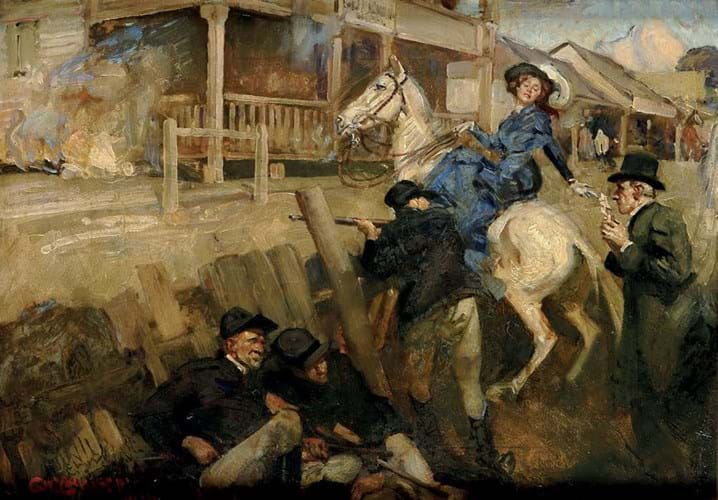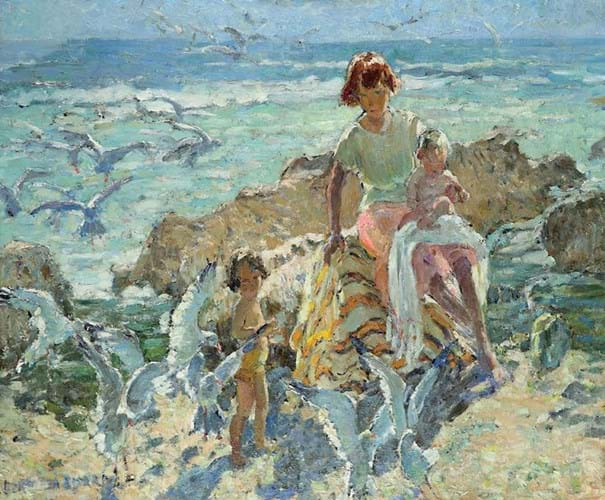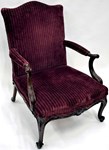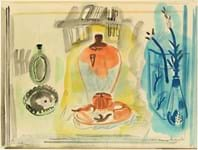
Ned Kelly is perhaps Australia’s most famous historical figure. The 19th century outlaw and bushranger, known for his audacious crimes against colonial authorities and distinctive home-made metal armour, is something of a folk hero to many Australians – a courageous underdog, despite the murders of three policemen by his gang.
In art, Kelly’s exploits have long provided commercial subject matter for many of Australia’s painters.
Last stand
An early 20th century oil painting depicting the last stand of the Kelly gang at Glenrowan in 1880 was the star lot in a buoyant Modern British & 20th Century Art sale at Salisbury saleroom Woolley & Wallis (25/12% buyer’s premium).
The work by the Australian George Washington Lambert (1873-1930) – a war artist principally known for portraits – had not been on the market since it was purchased in 1908 by Sir Walter Baldwin Spencer (1860-1929), an English-Australian biologist and anthropologist sometimes referred to as the ‘father of Australian archaeology’.
The siege was the gang’s last failed attack against police, during which Kelly was captured and his brother and other members of the gang lost their lives. Lambert eschewed the obvious subject of the famed outlaw himself and instead painted Kelly’s younger sister Kate astride a horse outside the Glenrowan Inn, trying to make her way past police and reach her brother within.
It appears that no other Kelly-themed pictures by Lambert have been offered at auction, suggesting this painting may have been commissioned. Interest was high and it sold to the Australian trade for £78,000, over five times the top estimate.
“The Kelly Gang have long been a popular subject for Australian artists,” said Victor Fauvelle, paintings specialist at W&W. “It is no surprise that the main bidders for this work were Australian, as the subject holds so much more resonance with them.”
Nolan and more
Other Australian works from a variety of sources also performed well in the £535,270 sale, which was just shy of 80% sold and took place on December 11, the day after Britain went to the polls.
Sidney Nolan (1917-92), whose own depictions of Ned Kelly are renowned, was represented in the sale by two 9 x 12in (24 x 30cm) mixed media works of Leda and the Swan. The classical tale was a long-standing subject for the artist who first painted it as early as 1945. Well-preserved and dated 1959, they sold for £1800 and £2400, the latter being signed.
A large 3ft 5in x 23in (1.05m x 59cm) oil on canvas of a young girl holding a flower in a meadow by the Australian Impressionist Iso Rae (1860-1940) with 1980s London gallery provenance sold to a UK buyer for £8500 (£2000-3000) and a 1990 acrylic canvas by the well-known Aboriginal painter Clifford Possum Tjapaltjarri (1932-2002) went to a bidder based in Europe for £7000 (£4000-6000). Showing the artist’s characteristic dot technique, used to suggest movement and rhythm, the latter was titled Men’s Corroborie, an event where Aborigines interact with ‘dreamtime’ through dance, music and costume.
Sharp summer
The contingent of British pictures at W&W contained one of the finest Dorothea Sharp (1874-1955) summer landscapes to be offered in the regions recently.
The sun-drenched scene of three figures on a rocky Cornish beach, executed in the artist’s highly impressionistic and spontaneous style, was taken to £55,000 against an inviting £15,000-20,000 estimate. The 2ft 6in x 3ft (77 x 92cm) oil on canvas came with provenance to London’s Paisnel Gallery and had been in a private collection for many years.
Contested above a £10,000-15,000 guide to £24,000 was a market-fresh British Impressionist regatta scene by the influential director and headmaster of the Glasgow School of Art, Francis Henry Newbery (1855-1946).
The 17in x 2ft 3in (42 x 69cm) oil on canvas was making its first appearance on the market in many years having passed by descent to the private vendor. It depicted Walberswick on the Suffolk coast where Newbery spent his summers, often with fellow artists such as Charles Rennie Mackintosh.
Salisbury portraits
The sale contained eight large-scale family portraits and allegorical oil paintings by Frank O Salisbury (1874-1962), Britain’s so-called ‘Painter Laureate’. The group formed part of the artist’s personal collection passed down to his descendants and periodically sold off by the Salisbury saleroom since 2013.
Hung in the neo-Tudor mansion the artist had built in Hampstead, the group included Sweetening the Hay, a rather unwieldy 3ft 6in x 6ft 4in (1.08 x 1.94m) oil that nearly doubled hopes to sell for £14,000. The remainder – portraits of the artist’s children and wife and a circular canvas painted for seed importer and golf enthusiast Samuel Ryder (of Ryder Cup fame) – sold for a combined £34,200.
















